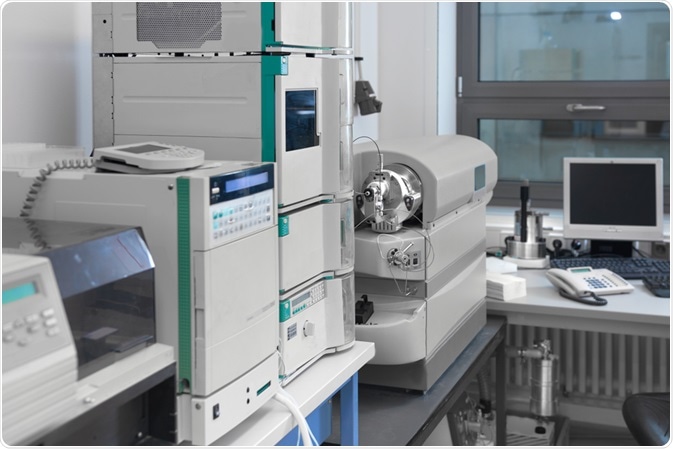DART-MS (Mass Spectrometry) is an analytical method used in science.

Image Credit: Anyaivanova/Shutterstock.com
DART stands for Direct Analysis in Real-Time. It is a version of mass spectrometry that can be used to analyze a variety of samples in a relatively short time-frame, without any particular sample preparation.
A wide array of different industries relies upon DART-MS to investigate the identity of a compound or to control the quality of their products.
Samples in the form of solids, liquids or gases can be analyzed with this technique which has become particularly well established in the fields of forensics, food, fragrance, toxicology, quality control, and environmental research.
How was DART-MS developed?
Cody et al. successfully created an alternative to the radioactive sources that were commonplace in handheld chemical weapons detectors. They sought to create an atmospheric pressure ion source to make these weapons detectors safer to produce and use.
This is how DART was born. In the early 2000s, the DART system was built which is thought of as one of the most significant developments that laid the groundwork for the field of ambient ionization, which now encompasses over 30 distinct techniques, although DART and another method known as DESI (Desorption Electrospray Ionization) are the most well-established.
How does DART-MS work?
Direct analysis in real-time mass spectrometry is a method of atmospheric pressure ionization. With this method, untreated samples or even complete objects can be analyzed in the open environment without concerns about affecting sample integrity. Therefore, the conduction of DART-MS takes place under ambient laboratory conditions.
The first step involves directly volatilizing the analytes by using a heated gas flow encompassing metastable helium (He) or Nitrogen (N) atoms. This process takes place in front of the sampling aperture, at the entrance of a mass spectrometer, with ionized molecules being released from the sample transferring into the mass analyzer.
When operating in the positive ion mode, this ionization of the analyte happens via either Penning ionization, ammonium attachment, or protonation. These processes produce M+, [M+NH4] +, and/or [M + H]+ ion species, respectively. However, negative ions can also be observed.
Applications of DART-MS
The method of DART is suited to the analysis of a wide range of substances in applications within a variety of industries.
Studies have shown it to be successful at analyzing hundreds of different kinds of chemicals, elements, and molecules, such as the metabolites of pharmaceuticals, as well as synthetic organic molecules, explosives, peptides, organometallics, oligosaccharides, and toxins.
Studies have shown that the DART technique is reliable in detecting these substances on several different surfaces, such as human skin, concrete, asphalt, banknotes, luggage, fruit and vegetables, paper, clothing, and more.
DART-MS’s capacity to accurately analyze such a wide variety of substances on an extensive list of surfaces has led to its establishment in many applications access industries.
Some of its most prominent applications include forensic analysis, where its uses are continually being developed, recently it has been extended to use in forensic paint analysis, proposed as a method to take over from optical microscopy in combination with infrared spectroscopy and pyrolysis-gas chromatography-mass spectrometry.
Another well-established application of DART is the study of factors that are relevant to the environment, with studying the ozone being one key application. As the technique can work in ambient settings with gas, it makes it well suited for analyzing the composition of atmospheric air.
Pharmaceutical applications of DART are another field where this method is well-established. This technique can be used to determine the potential risks and side effects of pharmaceutical drugs, as well as assisting in determining their effectiveness, and to tailor the dosages of drugs/pharmaceutical products.
Finally, DART is also being employed for several security applications, most notably for detecting the presence of controlled substances. This is one of the many reasons that led DART-MS to become an essential part of many crime labs around the world.
References:
- J.H Gross Direct analysis in real-time--a critical review on DART-MS Anal Bioanal Chem. 2014,Jan,406(1),63-80
- M.Maric, J.Marano, R.B. Cody, C.Bridge DART-MS: A New Analytical Technique for Forensic Paint Analysis Anal. Chem. 2018, 90, 11, 6877-6884
- M.J Pavlovich, B. Musselman, A.B.Hall Direct analysis in real-time mass spectrometry (DART-MS) in forensic and security applications Mass Spectrom Rev. 2018 Mar,37(2),171-187 .
- R.R. Steiner Use of DART-TOF-MS for Screening Drugs of Abuse Methods Mol Biol. 2018,1810,59-68
- S.Zhou, M.Forbes, J. P. D. Abbatt Application of Direct Analysis in Real Time-Mass Spectrometry (DART-MS) to the Study of Gas–Surface Heterogeneous Reactions: Focus on Ozone and PAHs Anal. Chem. 2015, 87, 9, 4733-4740.
- R.B. Cody; J.A. Laramée; H.D. Durst "Versatile New Ion Source for the Analysis of Materials in Open Air under Ambient Conditions". Anal. Chem. 2005,77 (8), 2297–2302.
- Ifa, Demian R.; Wu, Chunping; Ouyang, Zheng; Cooks, R. Graham. Desorption electrospray ionization and other ambient ionization methods: current progress and preview. The Analyst. 2010,135 (4), 669–81.
Further Reading
Last Updated: Oct 12, 2021